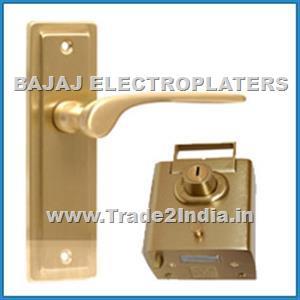BAJAJ ELECTROPLATERS
Featured Products
Highest quality standards are achieved through the implementations of latest technology, decades of experience and everlasting moral values , which have helped us to retain our customers as well as multiply them.
Welcome to BAJAJ ELECTROPLATERS
Zinc Electroplating

Zinc plating is the most common and economical type of plating. Zinc plating is a soft, protective by nature, decorative, ductile, marginally solderable and also serves as an effective undercoat for paints. It is sacrificial coating, so that part does not corrode. Zinc plating is available in clear, yellow, black and olive green. Trivalent chromate passivations are available if requested .
Benefits of Zinc Plating
- Ultra bright zinc deposit. Approaching that of chloride zinc.
- Excellent ductility & adhesion. Maintains ductility even with thicknesses in excess of one mil.
- A low stress deposit.
- Superior zinc deposit plate distribution.
- Consistent distribution.
- Excellent chromate conversion coating receptivity.
- Zinc deposit appearance is comparable to cyanide or chloride zinc.
- Operates within wide range of bath chemistry.
- Temperature tolerance up to 120oF, which reduces cooling costs.
- Excellent brightener stability and brightener life of 30,000 amp hours.
- Suitable for either rack or barrel plating.
- Simple waste treatment procedure.
- A reliable, easy to maintain process.
- It contains no complexers or chelating agents.
- Surface of the metal is cleaned in alkaline detergent type solutions, and it is treated with acid, in order to remove any rust or surface scales. Cleanliness is essential for successful zinc electroplating, as the molecular layers of oil or rust can prevent adhesion of the coating.
- Next, the zinc is deposited on the metal by immersing it in a chemical bath containing dissolved zinc. A DC current is applied, which results in zinc being deposited on the cathode. Alkaline zinc baths are used by the finished products, to produce a more consistent zinc thickness, especially in recesses.
- Hence an increased protection from corrosion is provided, as the corrosion of the deposited zinc is reduced. The zinc coating can increase the time required for the formation of white rust, by ten times. Finished Products also apply sealers, which are now commonly being specified by the automotive industry, further increasing corrosion protection.
It is very difficult to obtain a uniform thickness of coating, with electroplating technique. The thickness of the coating is very much dependent on the geometry of the object being plated, and it is preferentially on the external corners and protrusions of the metal body, hence not much of it is deposited on internal corners and recesses. Zinc electroplating process is used to make a clean, smooth and corrosion resistant surface. It also makes an excellent undercoat for powder coating or paint and can leave recesses on complex shaped components without sufficient zinc coating, in order to provide corrosion protection.
Our Vision
* To embrace new technologies and methods. * To give unsurpassed products and services to the clients. * To constantly look for improvement and changes.










